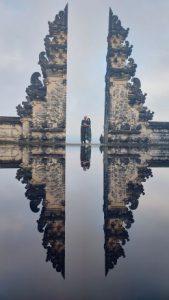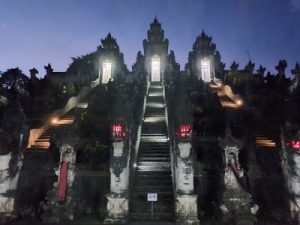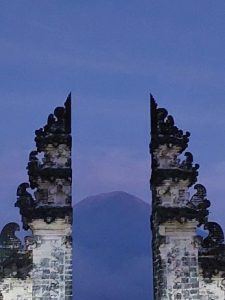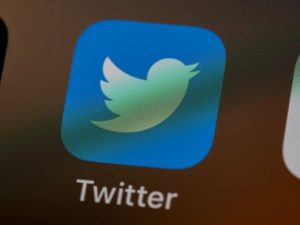
One nice thing about 2023 was that my partner and I managed to have a couple of international holidays for the first time since the start of the pandemic. Here’s a dispatch about Bali, which we visited in June. In it, your grumpy blogger makes a few uncomfortable discoveries about the nature of 21st century vacationing.
Not having done much research about Bali beforehand, I knew little about Lempuyang Temple other than that it provided a spectacular view, especially at sunrise, and was on every visitor’s must-see list. Two days after arriving in Bali, we embarked on our first tour and Lempuyang was the first thing on the schedule. The tour began at a fiendishly early hour. Our tour-guide collected us at four o’clock in the morning and we spent the next two hours in his vehicle, speeding along dark, mostly-empty roads to make sure we got to the temple early.
Just before six, we arrived at Lempuyang’s car-park, changed to a miniature, open-sided shuttle-bus, and were transported up to the temple’s reception area. We were given sarongs to wear, to comply with the place’s etiquette. Then we had to ascend a steep slope on foot to the temple proper. It wasn’t that long ago, we were told, that there was no shuttle-bus and visitors had to walk the whole way from the car-park, which would have been a slog.


We emerged onto a flat area that had at its back three stone staircases climbing to three doors. Presumably, the stairs and doors led to the temple’s inner sanctum, which was out of bounds to visitors. They were extremely ornate. The doors at the top, bathed in shimmering white light, were set in stone frames that resembled gothic pagodas. But the most striking features were the stone dragon-heads flanking the staircases at the bottom. Each had a lantern glowing within its jaws, so that crimson light seeped out through its fangs – though the straggles of stone in their maws looked less like fangs and more like the baleen of plankton-feeding whales. In the pre-dawn darkness, the lanterns’ glow made the heads blurry and ephemeral. It was as if they weren’t made of stone, but of still-malleable lava.
At the other end of the area was a classical Balinese temple candi bentar (split) gate. Its outer sides were steep and tiered, with decorous, upward-curling prongs, while its inner surfaces were vertical and blank. As the sky beyond changed colour from black to an ashy blue-grey, then to indigo, and then to a paler but smoky shade of blue, the sacred Balinese volcano Mount Agung became visible in the distance. The two sections of the gateway framed its rounded summit with perfect symmetry. Alas, the view rapidly clouded over and the mountain vanished again.

On the area’s other two sides were lengths of roofing, held up by wooden columns, white lights shining along their edges. Sitting under these roofs were a growing number of tourists, half of them Westerners, half of them Asians, nearly everyone accompanied by Balinese guides. We’d all come for a supposedly crucial part of the Balinese tourist experience – getting your photo taken in Lampuyang’s split gateway or, as it’s called, ‘the Gates of Heaven’.
Once the sun had risen, a crew of local guys started taking photos of each tourist, or couple, or group, while they posed between the Gates of Heaven. Ideally, this would have been with Mount Agung as a backdrop, though by this point it was no longer visible. I’d read complaints online from people who’d had to wait for hours until their turn to get photographed. This explained the roofing. Later in the day, with long queues, people would need shelter from the blazing Bali sun while they waited.
Our guide had whisked us there so early that we were number 12 in the queue. We should only have to wait a few minutes, get a quick picture snapped of us, and then be on our way to the next place on our itinerary. Right? Wrong. It wasn’t that straightforward. The subjects of the photos were allowed to strike a number of poses within the gates. And many of them milked that. They posed endlessly. I suppose this was our first encounter with the culture of the Instagrammers and social-media ‘influencers’ who infest Bali these days and clog up the Internet with images, clips and accounts of their marvellously exotic, interesting and well-travelled lives.
Some cringy poses were struck. I was particularly irked by one where the poser (in all senses of the term) would turn, show their back to the camera and point meaningfully towards Mount Agung in the distance – not that you could see it today, buried in the murk – as if they were an explorer who’d just discovered it. Also annoying was a pose popular among couples. He’d lean against one side of the gateway, she’d lean against the other, and both would look quizzically towards the camera. As if to say: Ain’t we a kooky couple? (Well, no…) Or one where the person or people simply jumped. They’d spring up and be pictured in mid-air with arms and legs splayed, looking like characters in a 1940s Warner Brothers cartoon being zapped by a powerful electrical shock.
To get your photographs, you handed your phone to the team of locals and they snapped you with its camera. It was rather a cheat, incidentally, that the photographer took the pictures with the phone positioned above a horizontal mirror. This created the impression that you and the gateway were standing at the edge of a pool of crystal-clear water, with a perfect reflection plunging beneath you.
Finally, our turn came. As all the previous subjects had done the jumping thing, and the photographer was in the habit of shouting “Jump!” in the middle of each photo-shoot, I gave him a stony stare when I handed over my phone and intoned, “No jumping.” So he took a few pictures and we struck a few affectionate poses within the gates – holding hands, embracing, nothing fancy. But he kept taking photos and kept telling us to strike new poses. We quickly ran out of ideas, and had to improvise, and ended up looking dorky. What an ordeal. This exhibitionism was not our cup of tea. Of course, all the social-media butterflies who’d come had probably spent days beforehand planning, deciding on and rehearsing the many poses they were going to make.

That was the main business out of the way, thankfully. Afterwards, we and our guide took a wander through the lower levels of the temple. I thought the Gates of Heaven actually looked better from below. They stood imposingly at the top of a grand flight of stone steps and above stone terraces adorned with clumps of ferns and clusters of white and red flowers. More dragon-heads loomed here too. A couple of chickens were making their way up the steps at the time, and I hoped some Instagrammer / influencer, narcissistically posing for photos in the gateway, would have their shots disrupted by the poultry sticking their heads over the threshold behind them.
As we descended the steep slope, to be picked up again by the shuttle-bus, the cloud obscuring Mount Agung furled itself into a long, white strand and revealed the volcano’s slopes and summit in their immense, pale-blue glory.

A treat awaited us. Our next stop was a more rewarding tourist attraction: Tirta Gangga Royal Water Garden.




